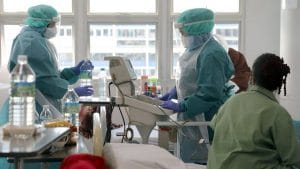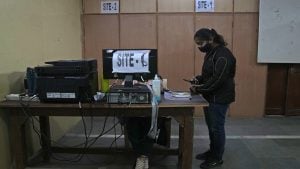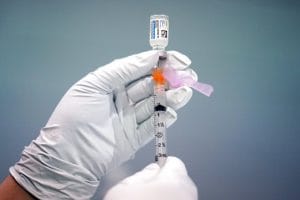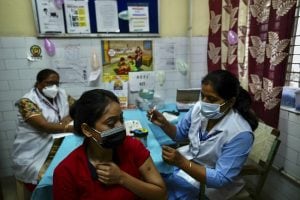Kerala’s nurses serving the world review their choices as they recover from the ‘Act of God’

KV Prasad Jun 13, 2022, 06:35 AM IST (Published)
 Listen to the Article (6 Minutes)
Listen to the Article (6 Minutes)
Summary
On International Nurses Day, we take a look at nurses from God’s Own Country, Kerala, who were working or studying in China and whose lives were upended because of the coronavirus pandemic. Despite this, they remain undeterred from their resolve to serve people, be it in India and abroad. Here’s a tribute to our healthcare workers.
“Have you seen the Pearl of Kochi? Isn’t it a beautiful tribute to all nurses?” asks Soniya Biju, a young nurse who was forced to return to Kerala from China after COVID-19 broke out.
Soniya was excitedly referring to a sculpture inaugurated in Ernakulam (Kochi) on Thursday — International Nurses Day — to honour all nurses and health workers who have been at the forefront of the battle to save lives. The “Pearl of Kochi” depicts the Earth placed atop the sails of a ship navigating rough waters — a befitting tribute to nurses.
Today, Soniya works at a mid-sized hospital in Kerala’s Changanassery with a large portion of her savings being swiped out of her bank account to pay off her education loans. Having studied nursing at the Yangzhou University in China, she worked for a year until the deadly virus struck. She was among the batch of nurses who returned to Kerala from China in January 2020.
Soniya, who comes from a family that survived on daily wages, told News18 that her parents were always keen on making her a nurse.
“My mother would always say a nurse’s job is God’s work. They saved money for years, and mortgaged our only piece of ancestral land to pay for my studies. They were thrilled when I got a job at a Chinese hospital, but then I could not afford the airfare. I took loans against my gold chain and earrings,” she recalled.
Describing the situation in China, the nurse spoke of gruelling shifts, strenuous work and constant fear of being infected by the virus.
“The job was back-breaking with the patients who were admitted in an extremely serious condition. We did not know Chinese and spoke largely in sign language. Many of them were not conscious. I had to take the risk of working to pay back loans and send money back home. But I finally decided to come back as my family was extremely worried about my safety, “ she said.
There were more than 23,000 Kerala students studying across 40 Chinese universities and all of them were forced to return to India. Upset with the cold response from the state and central governments on the future of medical students from China, protests were held under the banner of Foreign Medical Graduates Parents Association (FMGPA) — an association of parents of medical students in foreign countries. They have registered their grievance with the central government through an online portal — Centralised Public Grievance Redress and Monitoring System — and have yet to get a response.
“These students from Chinese universities are forced to take online classes now, but their future remains uncertain due to the non-availability of visas from the Chinese authorities,” Lekha Shankar, joint secretary of FMGPA, said.
“In order to secure jobs, practical and laboratory experience is essential and these students will not be able to undergo that training unless they return to China,” Lekha added.
“Back home, they will not get jobs if they don’t have practical training. So we are left with two options — help them go back to China or help with their training in India, even if it means they pay for it,” she added.
“We have spent close to Rs 20 lakh for my course. We have no idea whether the Indian government will accept our degrees earned through online classes. I have been earning practical experience from private hospitals near my hometown. But what guarantee do I have that it will be recognised? If it is not, we are doomed,” said Shameem Ahmed, studying with Zhengzhou University.
“The government has come up with solutions for students and nurses who returned from Ukraine; why not us?” asks Parvathy Unni, a fourth-year student from Dali University, located in the Yunnan province in China.
“I want to go back to China to complete my studies. I have no fear at all. Our university has made no decision about calling us back and the Chinese government also has no idea of what to tell us,” she said.
She explained that if students opt to study in India, they are forced to pay anywhere between Rs 8 lakh and to Rs 20 lakh per year for a government medical seat. That’s a whopping Rs 90 lakh to Rs 1 crore for a four-year course, an amount that out of reach for many.
In December 2021, in order to address the post-pandemic job loss situation, especially amongst the medical community, the Kerala government had signed an MoU with German Federal Employment Agency. This is a German government agency in charge of recruiting nurses from Kerala and providing job opportunities in the health sector in a post-pandemic world.
In a Facebook post, Kerala Chief Minister Pinarayi Vijayan said that the world is indebted to the sacrifices and services of the medical community, who bravely stood at the forefront of the struggle against COVID-19. He called it a matter of pride that across the world — not just in Kerala — Malayalee nurses were on the frontline of the fight against the pandemic.
“The German recruitment scheme is called ‘Triple Win’, and is the first of its kind in India held under the aegis of a government. More than 10,000 job opportunities are expected to come up for nurses in Germany in the post-Covid scenario,” said Vijayan.
One of the first major records of migration of Malayalee nurses was in the 1960s, when a group of around 6,000 nurses — mostly Catholics — were summoned to Germany which faced a shortage of health staff. Europe had been facing a severe shortage of healthcare professionals and these Indian nurses began to work in Catholic hospitals. They were slowly absorbed into the medical health system and were lovingly called “Brown Angels”. The nurses began to travel to Italy, Switzerland and other countries as their skill and sincerity was well appreciated.
Hospitals in Vienna recruited nurses from Kerala in the early 1970s through a Catholic order, ‘the Queen of the Apostles’, which was founded in Vienna in 1923 for missionising in India, says a paper titled, “International Mobility of Nurses from Kerala (India) to the EU: Prospects and Challenges with Special Reference to the Netherlands and Denmark”, by Praveena Kodoth and Tina Kuriakose Jacob.
“Nurses from Kerala were pioneers in opening up a new avenue of employment for migrants in Europe, the US and the Gulf and in taking up the position of the main breadwinners of their families. As their husbands and family began to follow them overseas, they reversed the gender pattern of migration. In the early phase, (the erstwhile) Bombay was the launching pad for nurses seeking to go to the Gulf countries, the US and East Africa,” the research paper stated.
Irudaya Rajan, Founder Chairman of the International Institute of Migration and Development, explains that its not just those who come from economically backward communities that pursue education as nurses — many who are financially well off as well. He said the estimated total foreign remittances to Kerala stood at Rs 85,092 crore in 2018 — 20 percent of the state’s GDP.
Kerala nurses are the brand ambassadors of Kerala in the world, said Benoy Peter, Executive director of the Kerala-based Centre for Migration and Inclusive Development, who also works on migration issues along with Rajan.
“Nurses belong to a specialist category of skilled professions stream of migration from Kerala. Nursing is one such open profession that opened doors for women to bring in foreign currency and it also empowered them considerably in decision making at their homes,” said Peter.
“Earlier nursing was looked down upon as a profession, but today, health workers are finally being given their due. Its not just nurses, but auxiliary nurses, like midwives and caregivers, who are also in high demand,” the migration specialist further explained.
So, why do so many nurses from Kerala go abroad to study and work? News18 spoke to several nurses who are working in countries such as the UK, Ireland, USA, Middle East and Australia.
There are three major reasons — subsidised education with state-of-the-art facilities, dignity of labour and the possibility of permanent residency.
While a nurse who is trained in India and works in the country would earn a salary between Rs 15,000 and Rs 50,000 per month, s/he would earn twice or even thrice as much in countries like the UK, Ireland and the Middle East. The money earned helps the nurses pay off the loans taken for their education and foreign placement in a short period of time.
Jom Francis worked in Kuwait for seven years and returned to India in 2020, just after the pandemic struck. He had been earning close to Rs 15,000 before he found a job in the Middle East.
“My salary was around Rs 50 thousand and helped me pay off my loans in the first six months of my arrival there. Unfortunately I had to resign and was placed on COVID duty in Bengaluru,” Francis told News18.
But his life was not all that rosy — nurses working abroad have to ensure hardships of a different kind. Francis talked about how the Kuwaiti hospital authorities would find reasons to terminate a nurse. “When we go with our medical fitness certificate from India there, we are asked to produce another one to get a job. Sometimes they claim we are unfit and send us back. Some of my friends did not even have money to return to India,” he said.
“Other times, they will to assign Indian nurses on duty, refuse leave to go back to Kerala and then terminate them if they protested. I received no increments for seven years, but managed to clear my loans,” he said.
According to EA Mohammed Shihab, state general secretary of the Indian Nurses Association, of the 5,000 nurses who pass out of 99 nursing colleges in the state, a staggering 3,500 pay to find placement abroad in Commonwealth countries and the Gulf region. Kerala has another 200 nursing schools that offer General Nursing and Midwifery (GNM) as a course, with 6,000 students graduating from them each year.
Last year, after months of agitation, nurses in Kerala were able to convince the state government to hike the minimum salary of a registered nurse employed in a 50-bed hospital to Rs 20,000 — an amount which is way below the payscale in other countries. It’s such a low pay that pushes this indispensable part of the medical community to other countries where working conditions are better, salaries higher and career more exciting.
Shahid , a male nurse from Tripura who works with a private hospital in Bengaluru, is all set to go to Dubai. He is aware of the difficulties in getting a job in a hospital but is ready for the gamble.
Like many nurses, Shahid comes from an economically backward family and has huge overheads and loans to pay. Having paid Rs 4 lakh for his nursing education , he wants to clear his debts within a year.
“Many nurses come from poor families and earn just Rs 3,000 to Rs 5,000 a month. I spent Rs 4 lakh for my nursing education and am confident that I will clear my loans in 3 to 4 months of working there,” he told News18.
Recalling his days during COVID duty, Shahid said the long hours in PPE kits and seeing death at close quarters strengthened his resolve to serve people. “The risk may be high with infections around, but the pandemic taught us many things and one of it was making us mentally stronger,” he said.
“It is about changing lives. Patients would be ill, unable to speak with their BP low or sometimes high. We chat with them, they smile and then their blood pressure stabilises. That gives me immense satisfaction. That’s the kind of good I want to do for people, “ he told this reporter.
Kottayam-based nurse Renita George was in the midst of packing when she spoke to this reporter over phone. She had been working for two years in a Chennai-based private hospital and was forced to resign as her health deteriorated due to extended working hours and lack of sleep. Recalling her harrowing days, Renita said that she would have to tend to 10 to 12 patients a day in the ICU and later be put on night shift .
“You cannot afford to sleep during your shift. I lost 11 kg and my family asked me to return. I have been selected to work in a German hospital and I am being paid thrice more than what I earned here, “ she said.
While money is one reason for nurses’ migration, another is dignity of labour. Saleena Shah is a nurse who has been working with the government medical college in Thiruvananthapuram for 33 years. She feels that nurses who take up the profession are passionate, compassionate people and it would not natter where they work as they are there to serve.
Unlike India, nurses abroad or registered nurses are empowered. Doctors consult nurses on medication for patients and also listen to their suggestions. Nurses abroad are held accountable for the health of their patients unlike in India. where the onus is only on the doctors and nurses are reduced to mere bystanders.
“When they work in other countries, nurses can take up other specialised roles such as a nurse educator, researcher or administrator. They can become nurse practitioners as well. There is growth for a nurse if they take up higher qualifications. In India, nurses are stuck in one role,” Saleena said.
Interestingly, she spoke of a new trend where many freshly graduated nurses in India have been turning towards civil services.
“The pandemic has taught us many things. It has taught us how we can bring in hybrid education by collaborating with universities across the world and give our nurses specialised education. Our hospital had a tie up with the Karolinska Institute, Sweden. Exchange programmes will help nurses to function better,” she added.
The possibility of a permanent residency in the country they work in is an added incentive for nurses to travel across the seas. Their children also receive quality education, and countries in Europe, Canada and Australia offer them permanent residency.
Monisha Stefen left for Canada in 2010 and obtained her Canadian nursing licence. She has been working as a nurse ever since. “My family, husband and two daughters applied for Canadian citizenship and we are expecting it to be cleared soon. Our quality of life has improved so much,” she said.
Even though a career in nursing helps in achieving the dream of a ‘good life’ , it all comes at a cost. There are huge challenges in understanding the culture, language and people of the new country. English may be accepted but in Europe, knowledge of French, Italian or Spanish becomes important.
However, on a happier note, the demand for Indian nurses has shot up post COVID, says the Indian Nurses Association.
“Requests from hospitals from many countries have been pouring in seeking applicants. There are more than 10,000 applications from different pending seeking our nurses expertise,” said an official from the Indian Nurses Association.

Elon Musk forms several ‘X Holdings’ companies to fund potential Twitter buyout
3 Mins Read
Thursday’s filing dispelled some doubts, though Musk still has work to do. He and his advisers will spend the coming days vetting potential investors for the equity portion of his offer, according to people familiar with the matter

KV Prasad Journo follow politics, process in Parliament and US Congress. Former Congressional APSA-Fulbright Fellow



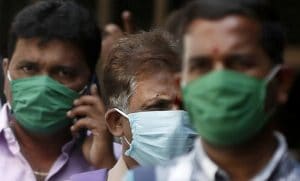






 Listen to the Article
Listen to the Article  Daily Newsletter
Daily Newsletter





